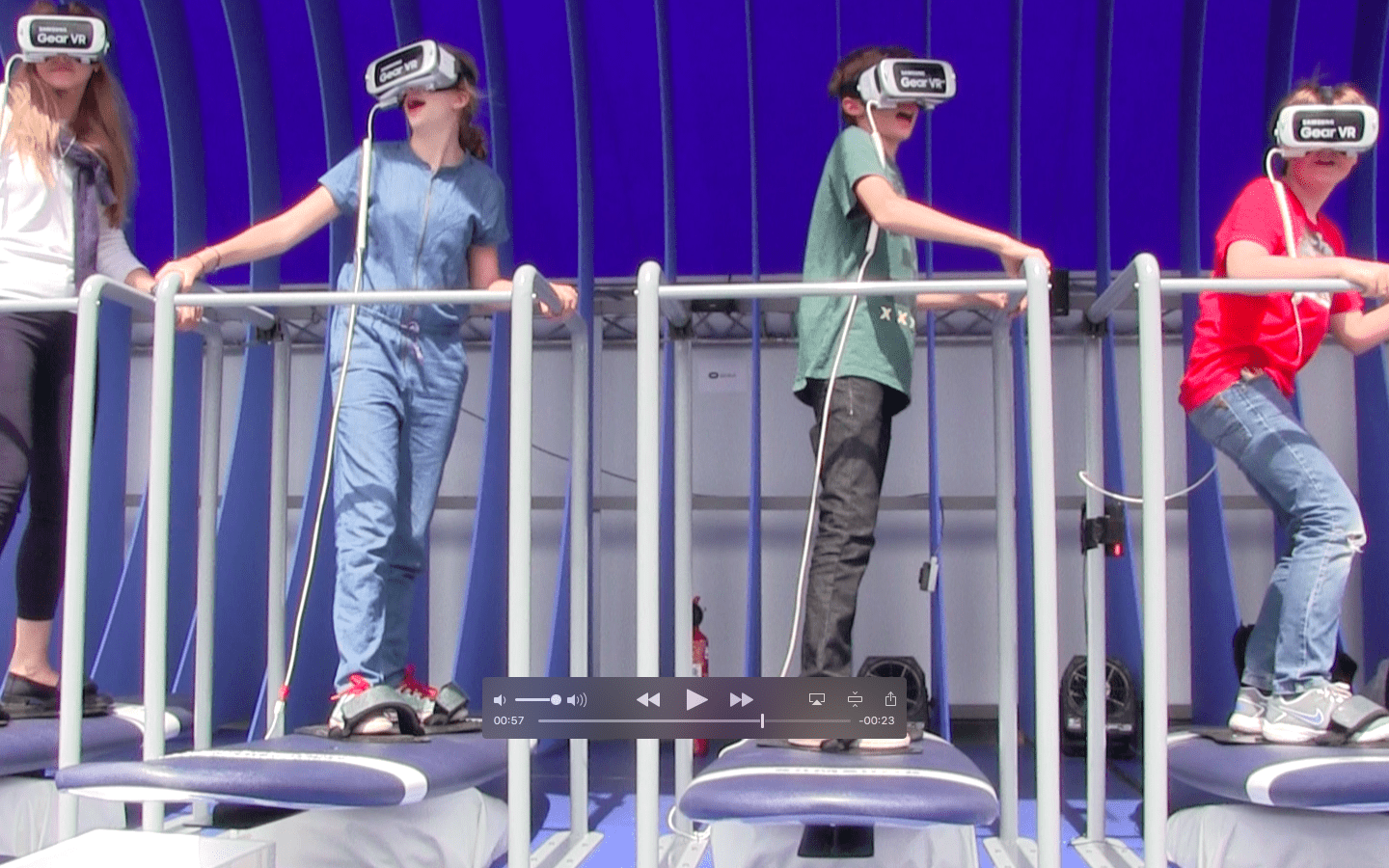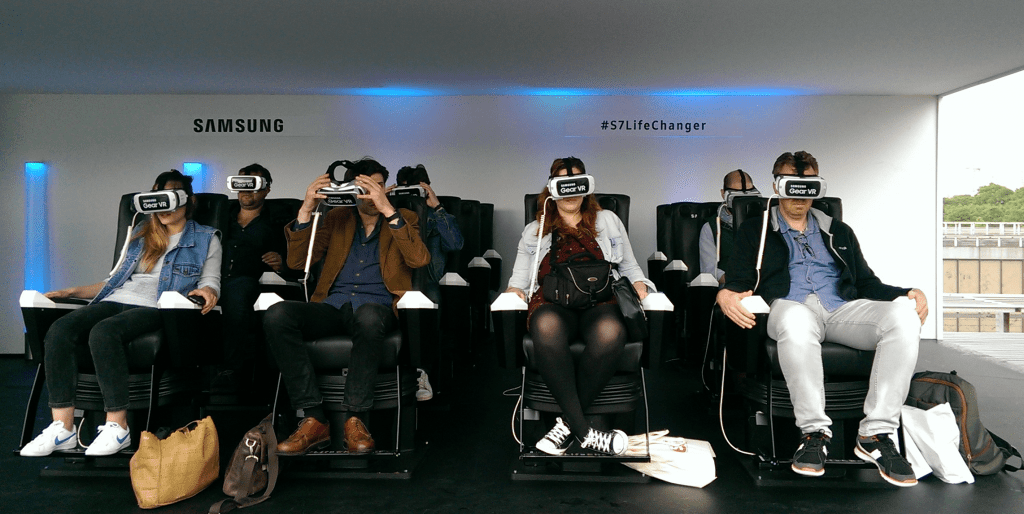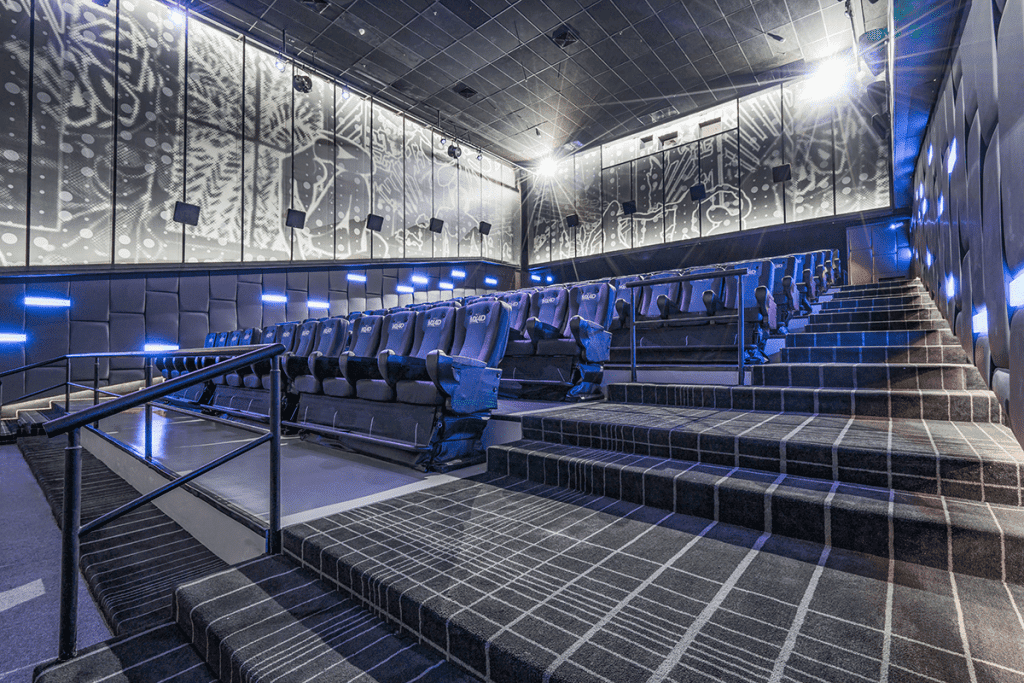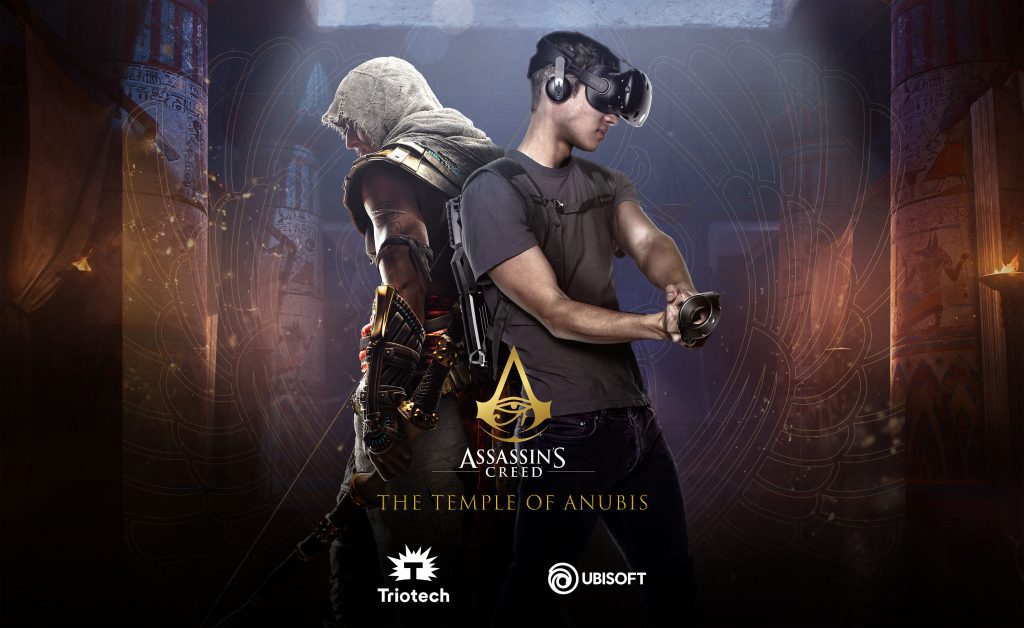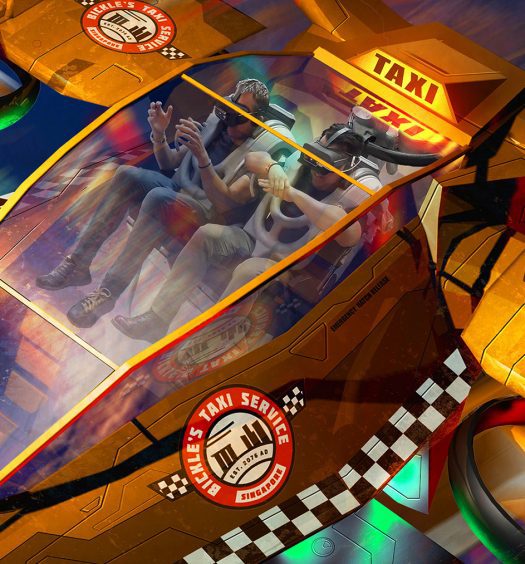Beth Whittaker looks at the increasing use of virtual and augmented reality and whether theme parks are really ready to fully embrace the technology
Justice League Madame Tussauds Image Courtesy HolovisONE of the main draws of a theme park for the public is often that escape from reality. Whether you are offering a thrilling, mystical, scary or comical experience through your rides and amusements, guests walk through those park gates wanting to leave their everyday lives (their own reality) at home.
While the core attraction areas remain the same – children’s rides, thrill rides, water rides and so on – how parks, and more importantly manufacturers, make these rides appealing to guests continues to evolve.
Digital attractions have been a part of the theme park experience for some time, with guests having come to expect to see them as part of the mix, particularly at the larger parks. The growth is such that the use of 3D and 4D motion theatres, while at one time confined to the theme park experience, is now regularly seen in smaller FECs and amusement arcades. The continued improvement of digital attractions in the home, such as computer games and smartphone games, has also upped guest expectation when visiting a theme park or choosing their leisure time activity.
While 3D and 4D technologies continue to hold their own in the amusement park sector, the use of emerging technologies such as augmented reality (AR) and virtual reality (VR) is allowing parks to build on the immersive experiences they offer guests – allowing them to truly leave their everyday lives at the park gates.
For Deborah Attal of attractions manufacturer CL Corp, all operators need to introduce some kind of VR or AR attraction in their parks, because as it stands today, they are the most immersive solutions that will allow visitors to dream and enter into a different universe. Earlier this year, CL Corp introduced a unique VR, dynamic waterproof outdoor attraction – a revolution for the leisure industry, especially for the waterpark sector – allowing parks to compete with other attractions and offer new sensations.
“The use of VR or AR will always bring that ‘magical’ effect and the general public now expect to be able to discover the world differently from any place,” Attal tells InterPark. “However, parks need to introduce the technologies intellectually. First of all, we must take into account the park’s philosophy, the theme, the opinions of the park’s customers and so on. Using these criteria, at CL Corp we create unique and tailor-made attractions according to the specifications required, with a film adapted to the theme and by adding special effects related to the film and the universe of the park.
“At CL Corp, we feel VR is the more important out of the two for the leisure industry moving forward,” she continues, “because visitors come to a park to experience new and exciting experiences. VR allows this to happen, whereas AR only adds part of the magic. VR is the complete creation of a new universe, whereas AR is the introduction of a virtual element only.
“Knowing how to make a VR attraction is to know how to make a dynamic attraction,” Attal adds, “with specific and precise special effects, but also – and above all else – a very good scenario and film, which is logical and creative and has a good resolution.”
MediaMation’s chief innovation and technology officer, Dan Jamele, agrees that VR is the way to go moving forward, with the company now basing most of its attractions on digital technology. In particular it is working with several VR applications both passive and interactive, as well as its theatre attractions that rely on 3D video projection.
On the VR front, MediaMation is coupling its MX4D motion bases with both custom applications and commercial games. The manufacturer is tying in the motion directly to the game play for the most realistic and flexible experience. Recently it has integrated with Steel Cobras from Rogue Initiative and Arch Angel from Skydance Studios, to create fully immersive, interactive VR experiences with the full motion and effects of its MX4D seats.
“VR and AR are extremely ‘hot’ right now,” Jamele tells InterPark. “They are a totally new twist on the decades-old concept of visual entertainment and the immersive qualities bring the customer into a world and experience that they otherwise could never enter. That is extremely powerful motivation to bring these types of attractions to the public.
“Certainly, there are commercial issues that still need to be overcome in order to bring these to the mainstream of attractions, but as technology and innovative ideas come into the market, this segment has tremendous growth opportunities, especially among the younger Millennials, who have so many entertainment options at their fingertips today. Adding in the elements that you cannot do at home, such as motion and effects, provides the extra dimension to get people out of their homes and into the parks.
“VR works well for us with our motion simulators because you are in a fixed position and experiencing motion and more – this makes the entire VR experience exponentially more exciting and fun.”
For Jamele, what technology allows us to do is to go places and experience whatever the storyteller wants us to. What kind of technology is required to make that happen varies greatly, however. For example, snorkel masks at a coral reef or a VR spaceship are different extremes, but both take you to somewhere else.
“Coupled with a smart and compelling storyline, all sorts of digital technology can enhance the attraction and make it something special, be it as simple as a touchscreen, or a full motion 4D VR setup,” he tells InterPark. “The guest wants to suspend their disbelief and experience something fun and out of the ordinary, which doesn’t necessarily mean using the latest and most expensive technology. Our job is to understand that and find the best way – no matter what the technology – to implement it within the budget and resources available for the attraction.”
For Peter Cliff, creative director of experiential design company Holovis, the importance of telling a good story is paramount, regardless of the technology used to make it happen. Some of the company’s most recent releases include Justice League: A Call for Heroes at Madame Tussauds Orlando and Sydney, along with Wicker Man at Alton Towers and The Walking Dead: The Ride at Thorpe Park, both in the UK.
“Story is now at the heart of theme park adventures,” he tells InterPark. “Even when going on a roller coaster, guests want to be emotionally immersed into a narrative that brings meaning to the experience. This has led to the increasing popularity of media and motion-based attractions. The next generation now revolves around real-time media, which is rendered from a game engine, meaning guests can have different experiences based on the decisions they make or paths they choose to take. This is the key to achieving customisation and personalisation of attractions.
“We believe the best technology is invisible,” Cliff continues. “It should always be chosen because it is the best method of facilitating the experience, rather than to be the star of the show. Using a certain technology for the sake of it often leads to the experience being disjointed and not thought through.”
For example, in the case of the Holovis Ride and Realm experience, the adventure can start on-board a dark ride and span into the wider park. Then, when guests return to the same ride, the experience has changed to tell them the next part of the story and set a new mission.
Holovis has extensively used AR to enhance guest experiences through its Extended Experience apps, which add an extra layer of narrative to a park visit and let guests engage in their own personalised adventure. For Cliff, AR is better than VR for group engagement and park wide adventures where guests still engage with the real world, but with an augmented second layer and adventure. These experiences, he says, form the basis of content rich social media posts, which guests share throughout the day, enhancing the park’s online presence and following.
It is interesting that Cliff should mention social media, as for Mustafa Mertcan, president of DOF Robotics, amusement parks should pay great attention to and concentrate their efforts on social media for publicity, Mertcan telling InterPark: “New innovations such as these equal new sensations of excitement and thrill for these parks. The target audience, who religiously follow such advancements and inventions, are also heavy social media users.
“Plenty of operators have been doing inspiring work with AR and VR in recent years,” he says. “Bearing in mind that a new generation with a passion for new technology is upon us, operators will do nothing but gain and benefit from these developments. As long as the technology behind AR/VR advances, the experience quality of the visitors will continue to improve drastically.”
Having received an award in the category of Major Ride at IAAPA 2016 with its Hurricane 360 VR, DOF Robotics started developing its newest creation, the Riot 360 VR, with which it is a nominee for this year in the same category. “This new product has received great interest,” says Mertcan, “especially in the US. We have combined the latest software developed by our R&D department, with wireless VR devices, Oculus Go.
“Both AR and VR will take their place in all parks over time,” he continues. “The technology is still very new right now but it is going to pave the way for other technologies, as well as helping 3D/4D technologies evolve for the better, allowing us to enjoy new experiences.”
However, new technologies such as these naturally come with teething problems and for Dan Jamele, the novelty of VR has, in some cases, been exploited, with cheap, low quality VR experiences tarnishing the industry.
“I understand the desire to be able to say ‘Wow, we have VR!’,” he tells InterPark, “but it needs to be compelling if it is to have longevity. The experience levels overall need to grow while keeping the cost down. Certainly the larger parks are in an all-out war for the most impressive and expensive attractions and that won’t change. They can do that and need to do that but the growth market for many is to identify and serve not only the larger projects, but have great options for the others throughout the world too. I believe the new generation of VR, AR and Esports offerings will bring in the old and new audiences as long as the story, implementation and content is high quality and attractive.”
For Triotech’s Christian Martin, the two main challenges in using VR at theme parks are capacity and hygiene, with some VR-equipped roller coasters seeing their THRC reduced by 40 to 50 per cent and some suffering even more extreme negative throughput impacts. For Martin, this is why second generation VR attractions, those designed to be a VR experience from the beginning, are the ones being implemented today.
“It is not that the capacity impact is removed but rather that it is calculated into the investment and ROI as well as operation plans,” he tells InterPark. “The hygiene issue is, in a way, being attacked the same way – by introducing operational parameters that take into account the extra steps of cleaning and so on that are necessary for VR attractions.”
“What guests like from a digital attraction is immersion and now, more and more, interactivity,” Martin says. “The guests will be ready to embrace new technologies such as VR and AR but in the end, they vote through the quality of the user experience. If the experience is amazing, they will want to try it again, they will tell their friends, post great reviews. Because of this, 3D and 4D attractions, especially interactive ones, are still relevant and for a couple of reasons. Firstly it’s a group experience – guests live through the attraction with their friends and family whereas in a VR attraction, they tend to be isolated because of the equipment. Then there is a question of the superior throughput capacity, which is crucial for parks and even FECs.”
“We have seen all sorts of creative methods to minimise the challenges of VR on a large scale,” adds Jamele. “But there are still hardware, hygiene and operational issues that need to be really solved for VR to hit its potential in the attractions field. The promises of lower cost visuals, more immersive experiences and smaller footprints make it a natural progression for parks… We are looking at solving these issues through innovative operational techniques and motion theatres, while targeting the smaller VR setups for trade shows, malls, promotions and so on. Our MX4D theatre at the TCL Chinese Theatre in Hollywood is VR ready and we are looking at different applications for that right now.”
But it is not only VR that comes with its issues; for many, while AR has some fantastic applications on phones and tablets, it is still a novelty and it may struggle to be widely successful in the theme park arena until a robust, cost effective wearable unit is readily available.
And as Peter Cliff explains, there is a growing trend of guests wanting to escape from their mobile phones at theme parks, rather than have experiences that rely on them. “Our new device-less tracking options are leading the way in achieving this,” he says. “These can facilitate similar experiences but instead of using a mobile device as the second screen in the world, they use biometric tracking to detect guests without the need for any additional technology or props.
“AR is a fantastic way of facilitating and extending experiences for guests, but it has to be the right method for the intended audience and to bring to life the desired adventure. The biggest ‘don’t’ is do not use technology for the sake of it.”
For Simon Clarke, creative director of visual FX studio Moonraker, VR and AR will continue to remain an ‘alternative technology’ rather than replacing 3D and 4D, as he explains to InterPark: “VR and AR is always a bit personal to the user… shared experiences will always attract a family audience, which is why I think we will end up seeing more flying theatre type rides in parks and on a smaller scale in shopping malls.
“Guests want to be entertained and surprised, so it is important that the storyline is at the heart of it and the quality of the content matches the capability of the ride system – VR can’t quite deliver on this yet. Audiences are becoming far more demanding with their expectations that, in this market, stem more from cinema than roller coasters. It is vital that the films we create deliver on that, with the seamless blending of visual effects and live action filming, delivered to a Hollywood standard.
“At Moonraker, we feel that flying theatre rides provide audiences with a virtual experience that rivals VR but with the huge advantage that it can be a live, shared experience where you’re not strapped to a headset.
“Flying theatres are gradually becoming more affordable as smaller, more compact units hit the market,” Clarke continues. “There are many more companies operating in this arena than a couple of years ago; it’s a good alternative to the VR technology and one that, for us, maintains the quality of the image on screen. We are working with companies such as Brogent, whose technology really supports the quality and epic scale of the rides we are creating content for.
So, while the industry is clearly excited by the potential of VR and AR technologies and what that means for attractions in the future, it would seem there are still plenty of chinks in the chain that need to be ironed out. It is also quite possible that VR and AR remain mostly niche, premium experiences with 4D interactive attractions remaining the most popular due to their all-encompassing nature. This is where AR perhaps ‘wins’ over VR, as Peter Cliff explains.
“VR and AR won’t replace 4D or media motion-based experiences, rather they can be used to extend and enhance the experience. By adding elements of AR to immersive theatre shows, guests can get their own unique view of the experience and possibly add a layer of gamification that evolves around the content even further. This maintains the group experience, immerses the audience and lets them explore in new and unique ways.”
And for Deborah Attal, while she agrees VR/AR will not replace 3D and 4D experiences, she believes they are the first step towards ‘hyper reality’ attractions, telling InterPark: “We aim to use these technologies and add others to create unique attractions – teleporting visitors into unique worlds of intense sensation. It is a great revolution for the entertainment world. Having said that, it is important that everyone pays attention to all the products on the market and turns to reliable and serious builders who listen to customer requirements. With bad technology, visitors can get sick very quickly because of the effect on the inner ear.”
As Dan Jamele sees it, for smaller areas and other attractions VR is the right choice. As the technology improves, however, he sees that we will definitely encounter more and more VR and eventually AR, at theme parks, as the cost and experience hold great promise.
“The future is bright,” he says. “And we want to give kudos to those forward thinking parks and operators that have taken the chance on these new technologies. Some are winners, some are losers, but without the risks, there are no rewards. Pushing the envelope and creating exciting attractions is what makes our industry so rewarding to work in and VR/AR is certainly breathing fresh air into both the creative process and the technical implementation. We look forward to seeing what develops over the next year!”



